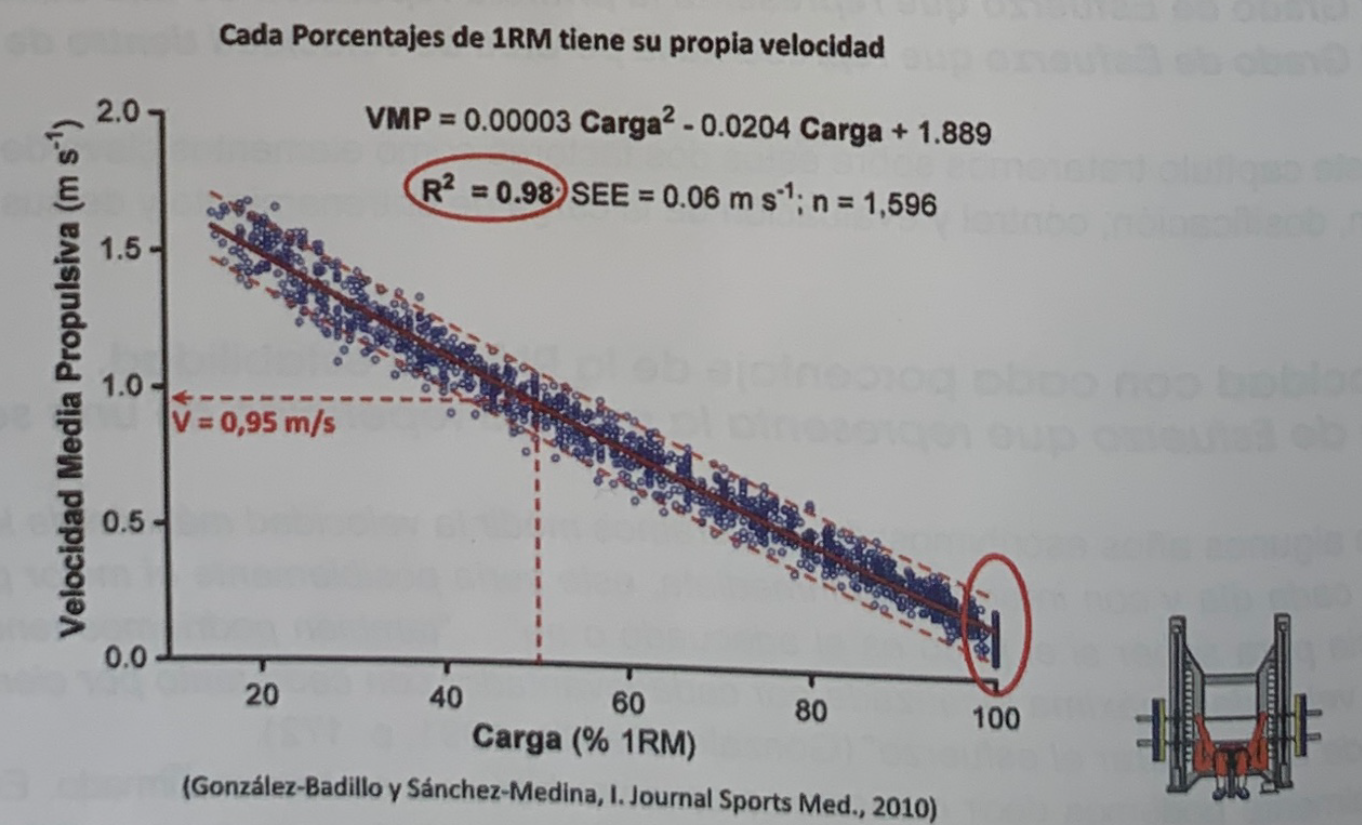Components of training load: intensity
Another component of the training load, the intensity depends both on the intensity’s own value and on the number of times (volume) that said value is applied. For this reason, whenever we talk about intensity, we will also talk about volume, and therefore, load.
In this series of articles we deal with some of the most important concepts of strength training, collecting notes from the recently published book Strength, Speed and Physical and Sports Performance written by renowned researchers Juan José González Badillo and Juan Ribas Serna.
Summary
- Intensity is the degree of effort developed when performing an exercise or training activity in repetition.
- The character of effort is the relationship between what has been done and what is achievable.
- The relative intensity is the percentage of the 1RM, which is the maximum weight that a subject can move in one repetition.
- The measurement of the 1RM displacing the maximum weight supposes an excessive effort and a risk for any athlete.
Training actions are rarely performed only once, the normal thing is to perform several times / several repetitions with a certain intensity. Therefore, both the intensity and the number of times each intensity is to be performed must be taken into account.
Intensity is the degree of effort developed when performing an exercise or training activity in each unit of action (repetition).
The intensity represents the degree of muscular activity developed to oppose a resistance, whether this resistance is constituted by one’s own body weight (which occurs with all the efforts that consist of jumping or moving the body in any medium without additional added loads), as if it were about overcoming an external resistance.
The most precise and sufficient way to determine the intensity when working with external loads is through the maximum possible speed of the first repetition in the series, but power could also be used when dealing with machines in which actions are performed. cycles that give power data as the product of force and speed. The maximum possible speed of the first repetition will always be accompanied by the maximum production of force in the unit of time (RFD) for the load, absolute, relative, with which you train.
The effort is defined as the degree of demand or demand on the organism (real load) of a physiological, mechanical, technical, emotional type in each unit of action. The relationship between the degree of demand and the current / real possibilities of the subject at a given moment constitutes the character of the effort (González-Badillo and Gorostiaga, 1993, 1995).
Therefore, the character of the effort is or expresses the load itself, that is, it defines it, and is determined by the relationship between what is done (degree of demand caused by the activity or work done, which is expressed by the series and repetitions performed before a determined absolute or relative determined load) and what is achievable (current possibilities of the subject, that is, the maximum work that the subject could perform: maximum number of repetitions in the series or in a set of series).
The character of effort is the relationship between what has been done and what is achievable. The maximum character would be the maximum number of repetitions in the series or set of series.
There are different ways of expressing intensity that are more in line with what is generally understood as “strength training.” Really, all training is strength training, because from a physical point of view, performance can only be improved by applying more force to the same load, that is, reaching more speed with the same load, which is what is intended with everything. type of training, except in weightlifting, in which the speed does not change, but the load that moves at the same speed.

absolute intensity
Weight (kg). Weight is an indicator of absolute intensity. It has the advantage that it can be used to compare the training of each subject with himself over time: speed change for the same load (weight). In addition, it is the best indicator of the relative load used by the subject and of the training effect if the speed with which each repetition is performed is controlled.
Relative intensity: Percentage of 1RM.
When it comes to displacing external loads the percentage of one repetition maximum (% of 1RM) could be used. This expression of intensity is typical of what we think of as “strength training.”
Advantages
This way of expressing intensity has some advantage, such as the fact that the load (weight) that each subject should use could be individualized, apparently in a simple way, no matter how large the training group was. You would simply have to indicate the percentage of 1RM with which you would have to train.
If the percentage of 1RM is considered and interpreted as “degree of effort” and not simply as an arithmetic calculation, it could also have an important application to indicate the evolution of the maximum relative load used in each training session or week.
If a person honestly wants to report his “philosophy”, his “theory” or his idea about training programming, he must do it simply, quickly and accurately indicating the maximum intensity (in this case the percentage of 1RM considered as “degree of effort”) of each session in the fundamental exercise or exercises.
This information is the most important, although, naturally, if the volume values are added with each intensity, the information will be more complete. This is so as long as the percentages are real, that is, they accurately represent the true effort that each percentage represents.
Drawbacks
1 – Time misalignment of the theoretical percentage: The MRI value is not the same every day. It tends to increase in a few sessions if the subject is not highly trained, and is generally below the maximum value measured before (usually weeks, months, and even years before) starting the training cycle when subjects are highly trained. However, in neither of the two cases are the changes stable, but oscillations occur within the improvement or stagnation of the MR value.
For all this, the effort made during the session can clearly differ from the programmed one. The drawback of this error is usually much more serious in trained subjects than in beginners, since it would be the trained ones who would run the greatest risk of training with loads higher than those programmed..
A clear and negative consequence of this situation, whatever the level of performance of the subject, is that we will never know with what load we have –
trained, which is quite serious, since we will be considering that the effect of the training, good or bad, obtained is due to loads or efforts different from the real ones. Dragging this problem would never improve our training methodology, because we would almost always handle wrong data.

2 – That the value of the MRI is not real: A high percentage of the measured MRIs are false. Given that each exercise has a speed of its RM (González Badillo, 2000), the RMs will be false whenever the subject reaches his RM at speeds higher than the speed of the RM of the exercise (there is no other possibility of error because at measure 1RM the speed can never be less than the speed considered as typical of the RM of the exercise).
The more the speed at which the RM has been measured moves away from the speed of the exercise, the less accurate the measurement will be. This lack of precision is always manifested by resulting in an RM value that is lower than the real or true value, although, naturally, the true value of the RM will never be known.
Therefore, when we speak of “true value of the RM”, we must understand a value of RM reached at the speed of the exercise or very close to it. This means that each load (weight) that we use, taking a false RM as a reference, will always be a lower real percentage than the programmed one. This circumstance means that this error has fewer negative consequences for training than other errors, since we would always train with loads lower than those programmed.
3- The effort represented by each percentage of 1RM is different depending on the exercise: To the previous drawbacks we must add that, even if the real percentage of the RM represented by each weight is known, the effort represented by each percentage is different depending on the type of exercise. This different effort depends on the speed of the RM.
For example, a load of 85% 1RM represents a very different effort than a bench press and a power clean. These differences are due precisely to the fact that the speed of the RM is different for each exercise (González Badillo, 2000).
4 – The measurement of 1RM supposes an excessive effort and with risk for any athlete, and especially for young people: Based on what we have just indicated in relation to the inconveniences of measuring and using the RM as a reference, it is reasonable to conclude that the RM does not should never be measured. It can be estimated through speed.
With respect to the dosage, we have already given the arguments, and as regards the assessment of the effect of the training, it only serves, in a not very precise way, to know the effect of the training on the maximum load (loads that move at very low speed), but not for all other loads or speeds.
The measurement of 1RM supposes an excessive and risky effort for any athlete, and especially for young people.
XRM or nkM
This The way of expressing the intensity of the training indicates that the maximum possible number of repetitions should always be done with the load (weight) that is being trained. The X and the “n” represent the number of repetitions to perform. It is understood that being able to perform a certain number of repetitions means that you are working with a certain intensity or percentage of 1M, since with each percentage of 1RM you can perform, on average, a certain number of repetitions. This way of expressing intensity includes volume, and is very common in expressing training, especially when it comes to studies that intend to be published.
This way of expressing or dosing the training load does not present any possible advantage. So we will only talk about its drawbacks.
The first observation regarding this type of expression and dosage of intensity is that doing the same repetitions with a certain load does not mean that you are working with the same percentage. The maximum value of the range in which the number of repetitions performed at the same intensity is found, from 50 to 85% of the RM, can double the minimum value, with an average coefficient of variation of 20% (González-Badillo et al. al.. 2017). Therefore, two subjects who have trained with the same number of maximum repetitions per set may have trained with very different relative loads.
1RM should never be measured
The second observation regarding this type of expression of intensity is that it is not possible to perform more than one series with the same load (weight) and the same number of repetitions when this has really been the maximum possible for the subject in the first. series. Therefore, it is not realistic to propose a training such as: 3x10RM, which means that the subject must perform 3 series of 10 repetitions with a load (weight) with which, in the first series, they can only really perform 10 repetitions. .
Another big drawback is that, by always training with the maximum number of repetitions possible per series, Even if fewer repetitions are made in successive series with the same weight, at least the following negative effects can be produced: excessive fatigue, increased risk of injury, and reduced execution speed under any load. (high loss of speed in the series). All this can lead to reduced sports performance.

Lastly, it has been observed that performing the maximum number of repetitions possible in each series does not provide better results than performing the same number of series and fewer repetitions per series with the same relative intensity (González-Badillo et al., 2005; González-Badillo et al., 2006; Folland, et al , Izquierdo, Ibáñez et al. 2006 Groeller, 2016; Drinkwater, et al., 2007; Willardson, et al., 2008: Pareja-Blanco et al., 2017) nor on other untrained exercises (Pareja-Blanco et al., 2017)
From all that has been said, it can be deduced that it would be very reasonable for no XRM value to be measured, neither for training nor to assess the effect of performance.

















